Did you know only 74.98% of top ranking pages have meta descriptions? In search results, websites should maintain their consistency, and an integral part of this success is the effective use of SEO meta titles and SEO meta descriptions, a behind-the-scenes worker that is often overlooked by users but carries significant weight with search engines. As we slide into April 2024, let us explore the ins and outs of SEO meta title tags in this guide, covering everything from the basics to algorithm-driven optimization strategies tailored for the future.
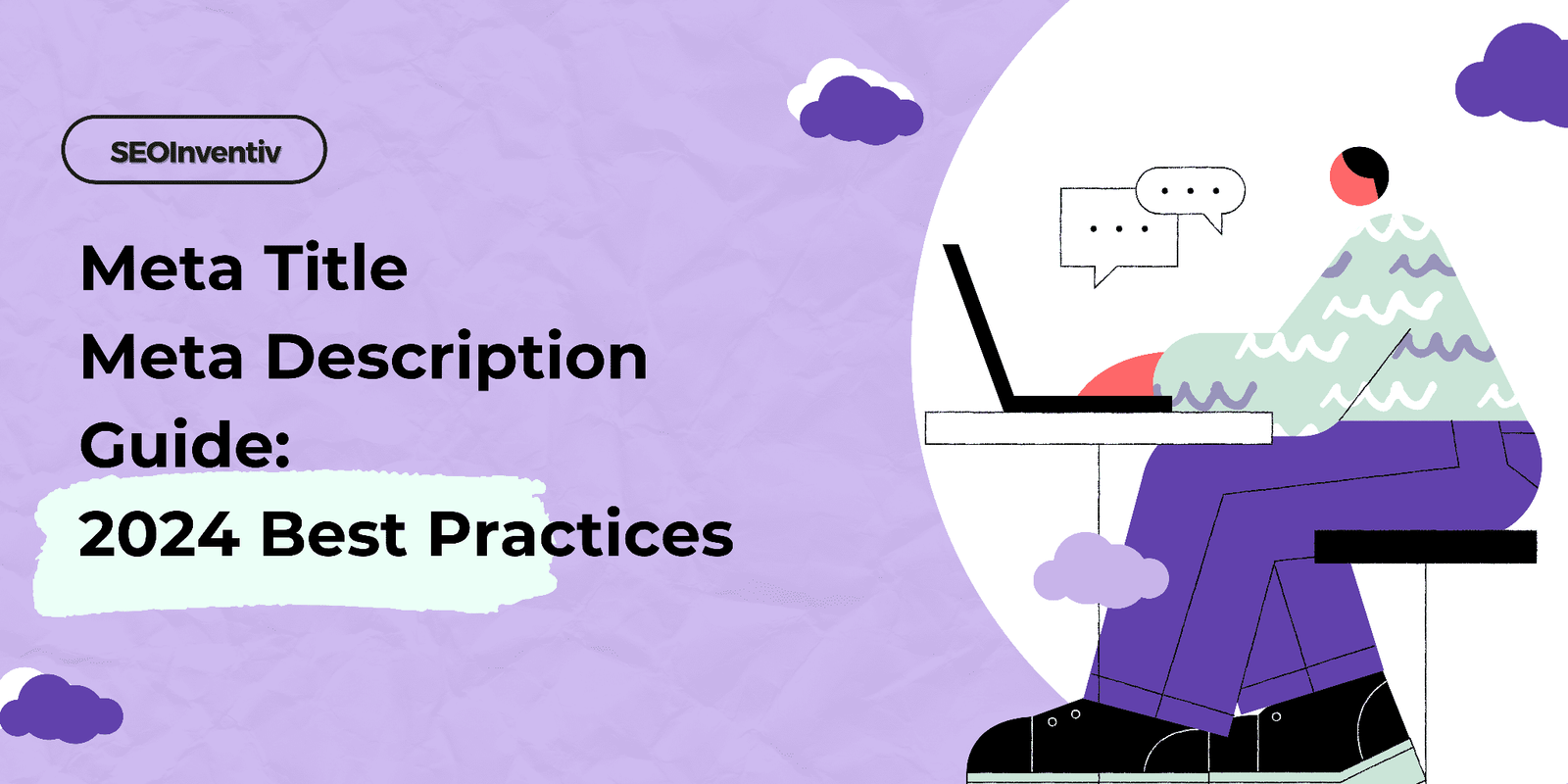
What is a Meta Title in SEO?
The page title, or meta title, is a required element in HTML and is listed in the <head> area of the document. Alternative names for the meta title are “meta title tag,” “page title,” or simply “title.” The addition of “meta” is theoretically incorrect because it is not a meta specification in the true sense. In practice, however, the name is counted as metadata in the header of a web page.
How do I craft a meta title that converts?
Writing a meta title is challenging, and what is more difficult than writing a descriptive and compelling meta title? Meta titles are not new in this digitalized world, and you are all aware of them, but you might not know that writing meta titles is a little mix of art and science. And that is why we said crafting a meta title is challenging. But worry not; we have given you the tips to master the creativity of crafting compelling meta titles. Have a look below.
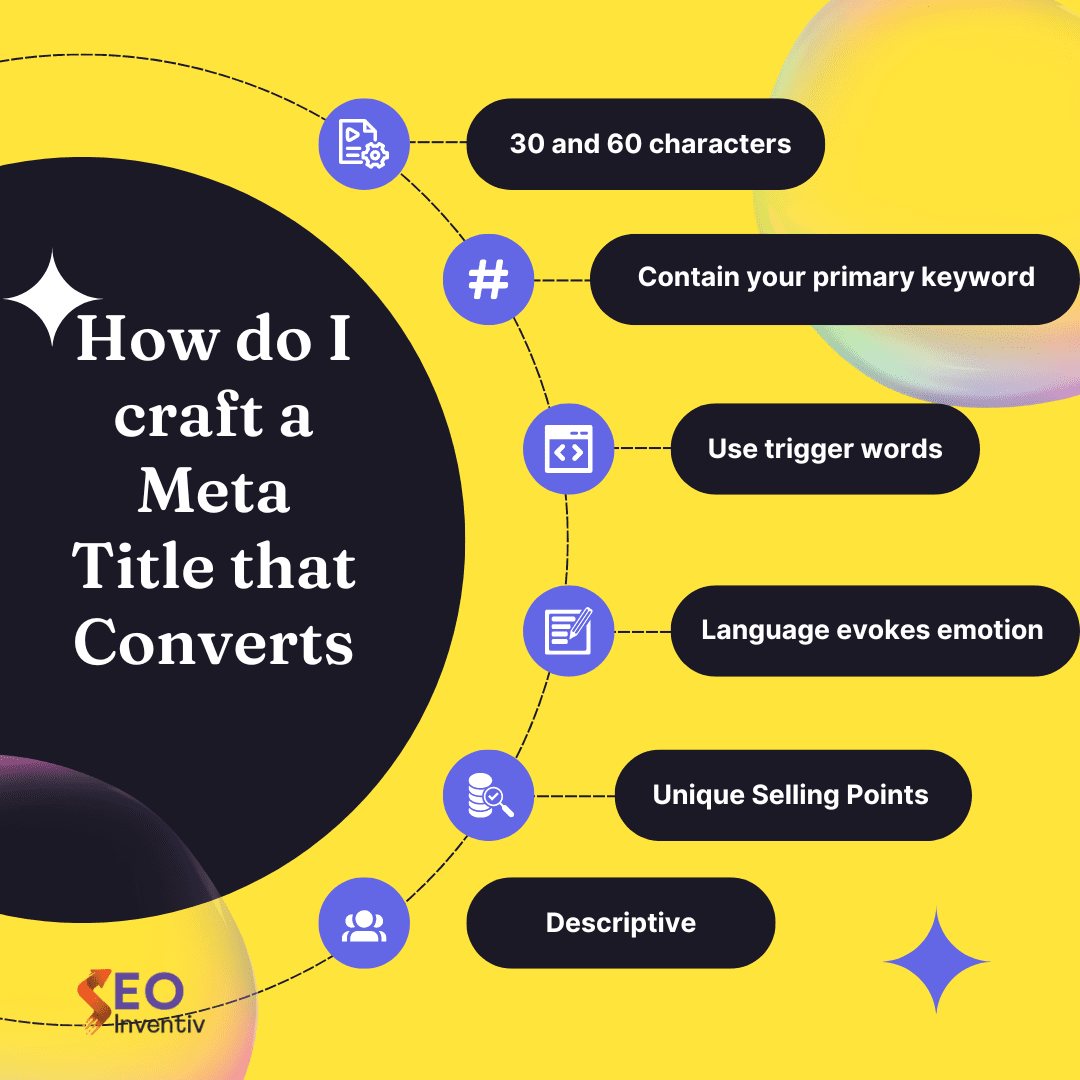
- A meta title should always be between 30 and 60 characters.
- The meta title should be descriptive and contain your primary keyword.
- Use trigger words that trigger emotions or psychological reactions, such as get, try, learn, grow, exclusive, limited time, secrets, special offer, urgent, last chance, hurry, free, and guarantee.
- When you use language that evokes an emotional response, you can attract more clicks.
- To generate more clicks, one should include unique selling points in their meta titles. Such as the best, certified, 1 hour emergency service, free estimates, and many more.
Meta Title Checklist
Imagine crafting the perfect web page only to have search engines display a bland, uninformative snippet that nobody clicks on. That’s the power of meta titles. These short snippets are your website’s first impression in search results, and in 2024, crafting compelling titles is more crucial than ever.
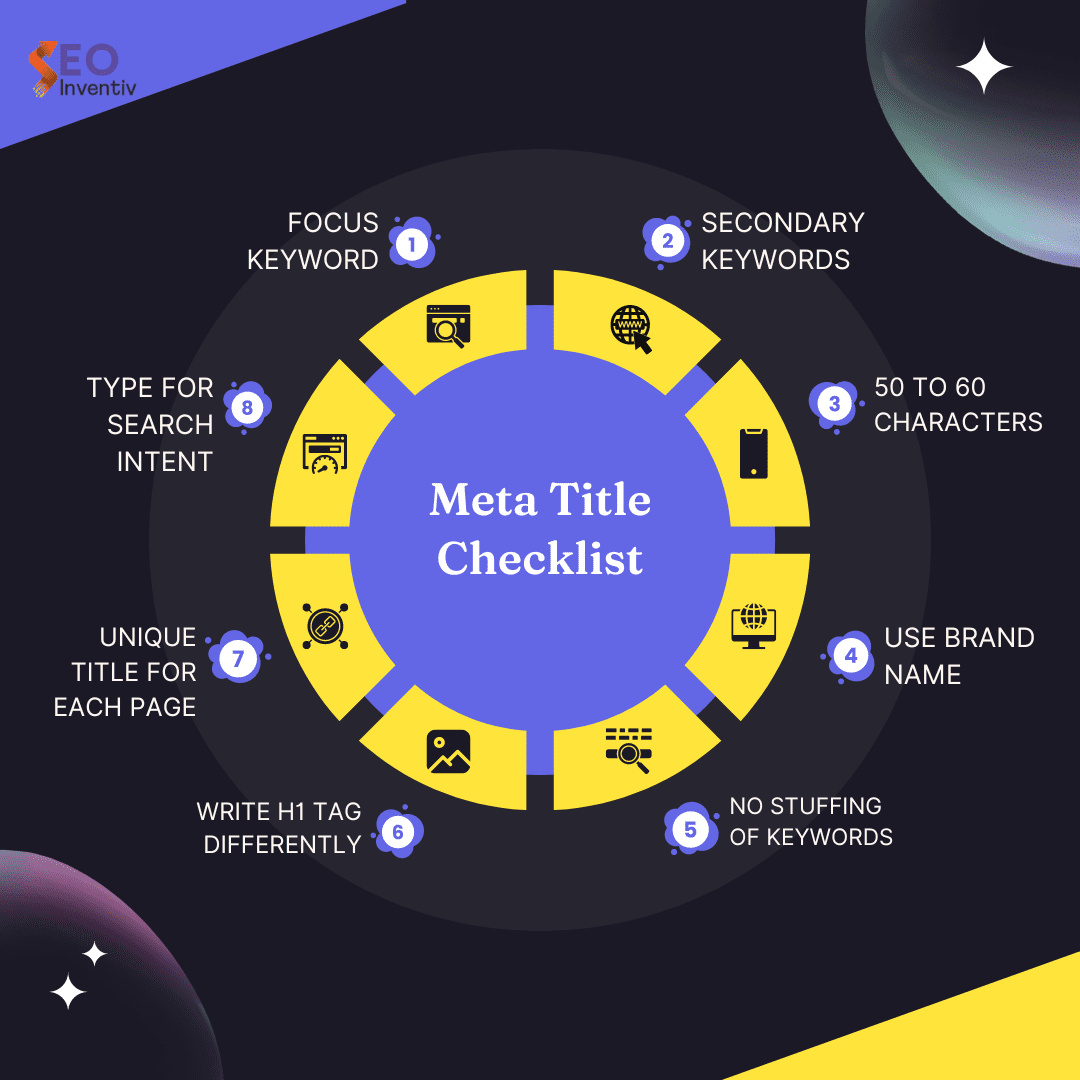
This checklist will guide you through the essential steps to writing meta titles that grab attention, accurately reflect your content, and boost your SEO ranking.
1. Place your focus keyword near the beginning
Use your focus keyword as close to the beginning of your meta title as possible without sounding unnatural. Don’t add it at the start if you can’t get it to work.
2. Of course, include secondary keywords
If possible, use a secondary keyword with the same search intent in the title. For example, “SEO copywriting” is a primary keyword, and “how to write seo copy” is a secondary keyword.
3. Write about 50 to 60 characters
Your meta title tag should be 50 to 60 characters long, including spaces. Also, keep your brand name in mind when considering this meta description length. It’s okay to go a little over or under if you have to, but try to stay within that range.
4. Enter your brand name
It’s generally a good practice to include your meta title tag at the end of the meta title unless the meta title tag name is a highly relevant part of the page’s theme. This should happen automatically, unless you manually change it.
5. Do not stuff it with keywords
Don’t stuff your meta title with keywords. This will not improve your results and will reduce your chances of ranking due to compromising the user experience. Write for people first.
6. Write the H1 tag differently
Consider writing the H1 tag differently. You can use slightly different keywords with similar search intent or extend them if necessary to improve the user experience. If not, leave it the same.
7. Write a unique meta title
Give each page a unique meta title. It’s okay to use a similar meta-title structure for a large number of service or product pages as long as each page is differentiated by a factor such as location.
8. Type for search intent
The most important thing is to write naturally according to the search intent of the users. Try to understand what they are looking for and write a title that appeals to their goals. Ask yourself if you would click on it above the other results if you were them.
What Are The Common Meta Title Mistakes To Avoid?
Meta title is the first impression you make on search engine users, and it needs to be clear, informative, and attention-grabbing. But just like headlines, meta titles are prone to mistakes.
This section will unveil the most common meta title pitfalls and guide you on how to craft titles that soar in search results. By avoiding these missteps, you’ll ensure your content gets the visibility it deserves and watch your traffic increase!
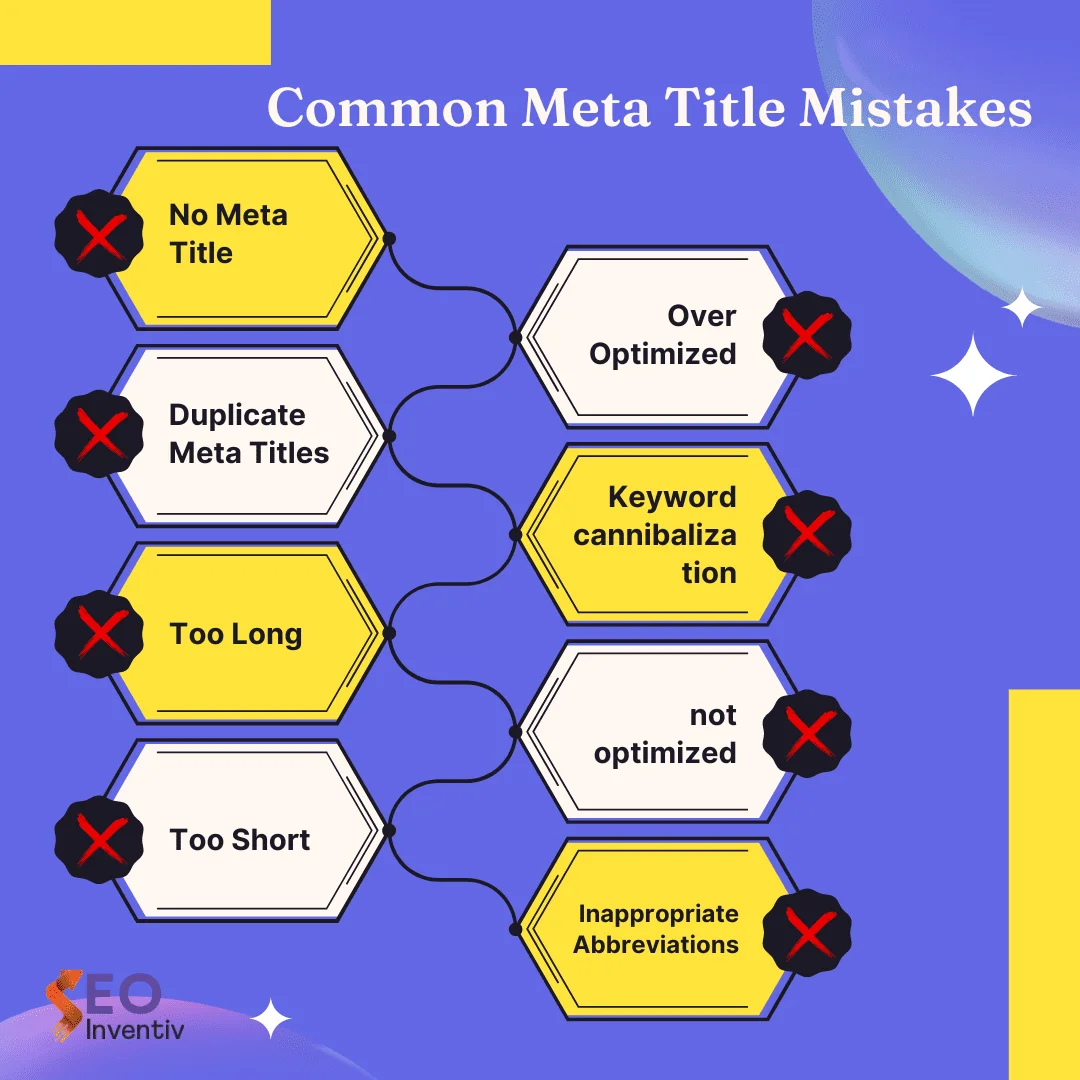
- You are not creating any meta titles.
- There are duplicate meta title tags.
- The meta titles are too long to be read by Google crawlers.
- Your meta title is very short and does not make sense.
- The meta titles are over-optimized.
- Keyword cannibalization.
- Your meta titles are not optimized for local search.
- The meta title contains inappropriate abbreviations.
- Your meta title provides no value to the reader.
- The keyword you are using as primary is not at the beginning of your meta title.
- They are not written according to the content and description of the metadata
What is a meta description in SEO?
Meta description is an HTML element, and it may appear as a snippet below the URL and page title on Google search engine results pages (SERPs). The snippet of pages is automatically generated by Google based on the search query.
How to Craft Meta Descriptions that Convert
Meta Descriptions are snippets that are your golden opportunity to hook searchers, entice them to click, and ultimately drive traffic to your website. But with limited characters and fierce competition, how do you craft meta descriptions that truly convert? Let us find out.
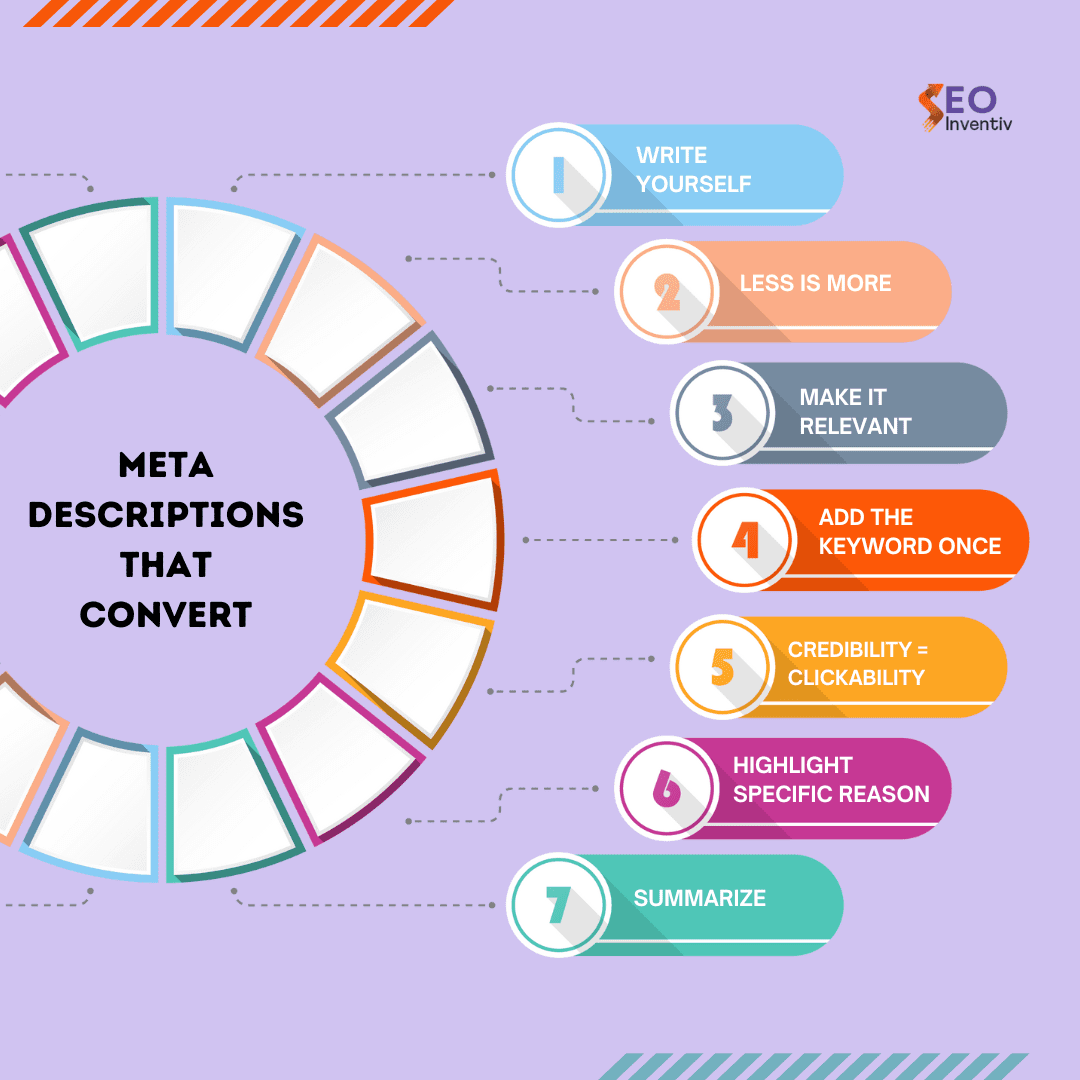
1. Write it yourself
If you don’t write your meta description, Google will generate it automatically, and you’ll end up with 188 characters of free information, which is the first thing Google finds on your page and has no value.
2. Less is more; don’t exceed 160 characters
The ideal meta description length is about 155-160 characters. Although you can add up to 188 characters, several studies show that meta descriptions with up to 160 characters achieve the best results.
3. Make it relevant and summarize
Your meta description must be relevant to your content. If you mislead searchers with under-promises or other misinformation, your bounce rate will increase drastically.
4. Add the keyword at least once
If you want to technically optimize your meta description, you should add your keyword at least once. This shouldn’t be that hard if you’ve chosen the right keyword, because your keyword mostly sums up your article.
5. Credibility creates clickability
Make sure people see that your website is trustworthy. Moreover, it builds trust and helps you drive traffic.
6. Highlight a specific reason for reading
People want to know what they are dealing with, so use words of value and let them know exactly what you have to offer. Give them a reason to click through and read your content.
What Are The Common Meta Description Mistakes To Avoid?
You’ve crafted the perfect webpage with valuable information. But how do you ensure search engines and users know it exists? That’s where meta descriptions come in. But creating descriptions that truly shine isn’t always easy. Let us explore some common meta description mistakes to avoid so you can write descriptions that captivate and convert!
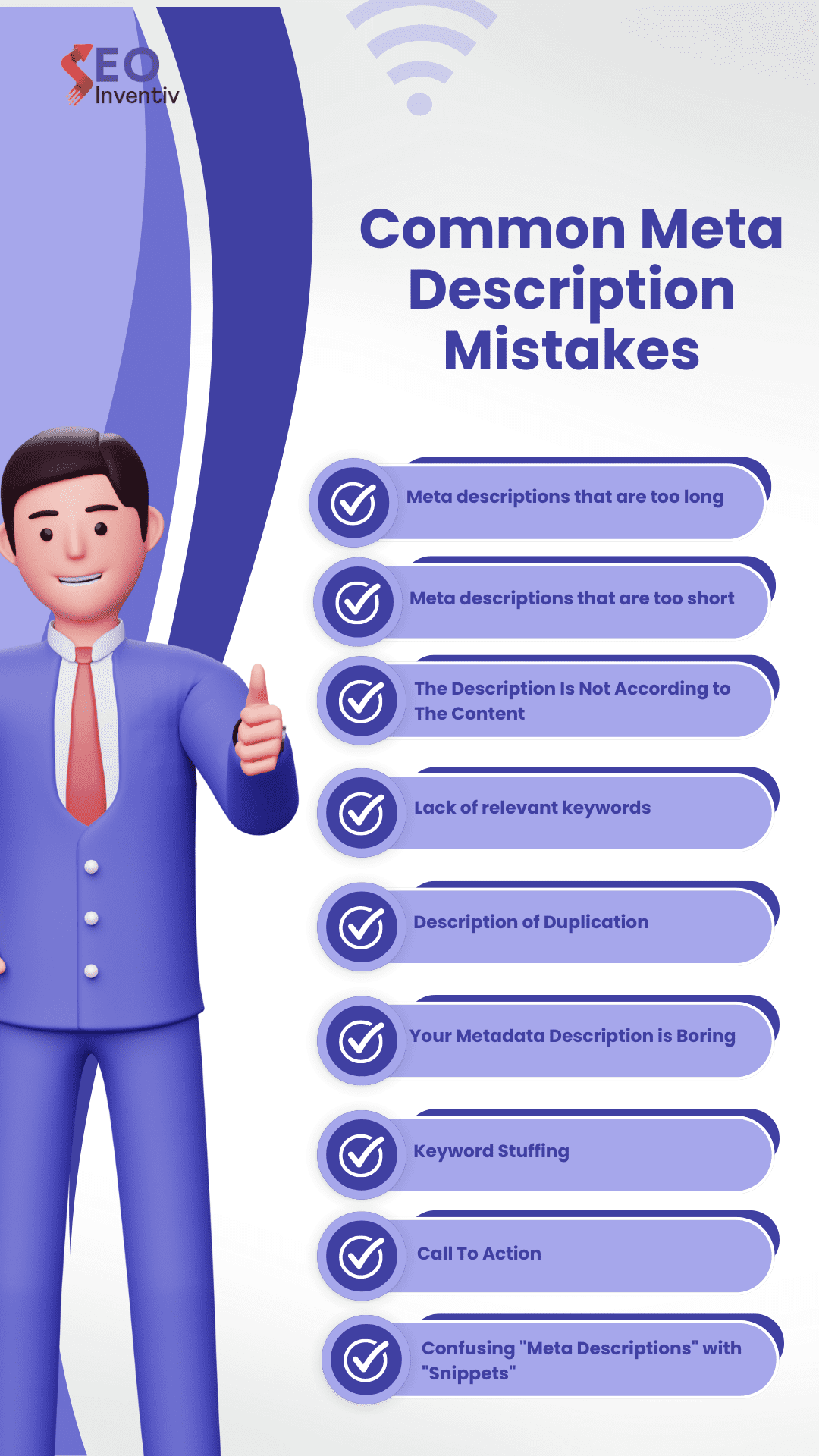
1. Meta descriptions that are too long
A general rule of thumb for the maximum meta description length is 160 characters for desktop and 120 for mobile. It’s interesting to note that Google tends to take a little more leeway with characters when they create descriptions.
2. Meta descriptions that are too short
While brevity is important, it stands to reason that you should still make the most of the space set aside for summarizing and promoting your content. Search engines are likely to view short meta descriptions as lacking in information and, therefore, quality.
3. The Description does Not correspond to The Content
Meta descriptions are meant to summarize the page they are linked to.
4. Lack of relevant keywords
Think of the meta description as a place where you can expand on the title of your website. Be sure to include enough relevant and topically related keywords to signal to search engines and your target audience that the description is indeed consistent with the content on the page it describes.
5. Description of Duplication
Duplicate meta descriptions that appear on multiple websites are usually the result of the website owner being lazy or cutting corners.
6. Keyword stuffing
Inserting the same or very similar keywords into web page content is a clear SEO no-no, and the same goes for meta descriptions. It’s a good idea to include your primary keyword or phrase in your page description to be consistent with your page title and possibly your URL.
7. Your Metadata Description is Boring
As mentioned, meta descriptions have a dual role: they describe the web page and reach the desired audience through search engine results.
8. Omission of a call to action
One should add a call to action to fully describe the content and context of your page if you still have room.
9. Confusing “Meta Descriptions” with “Snippets”
Meta descriptions (the words you type) and snippets (the words that search engines display in SERPs) are not the same thing. As mentioned above, Google can only use your metadata description 30% of the time. There are many types of snippets and best practices for creating and optimizing content for selected snippets.
Meta Descriptions Checklist
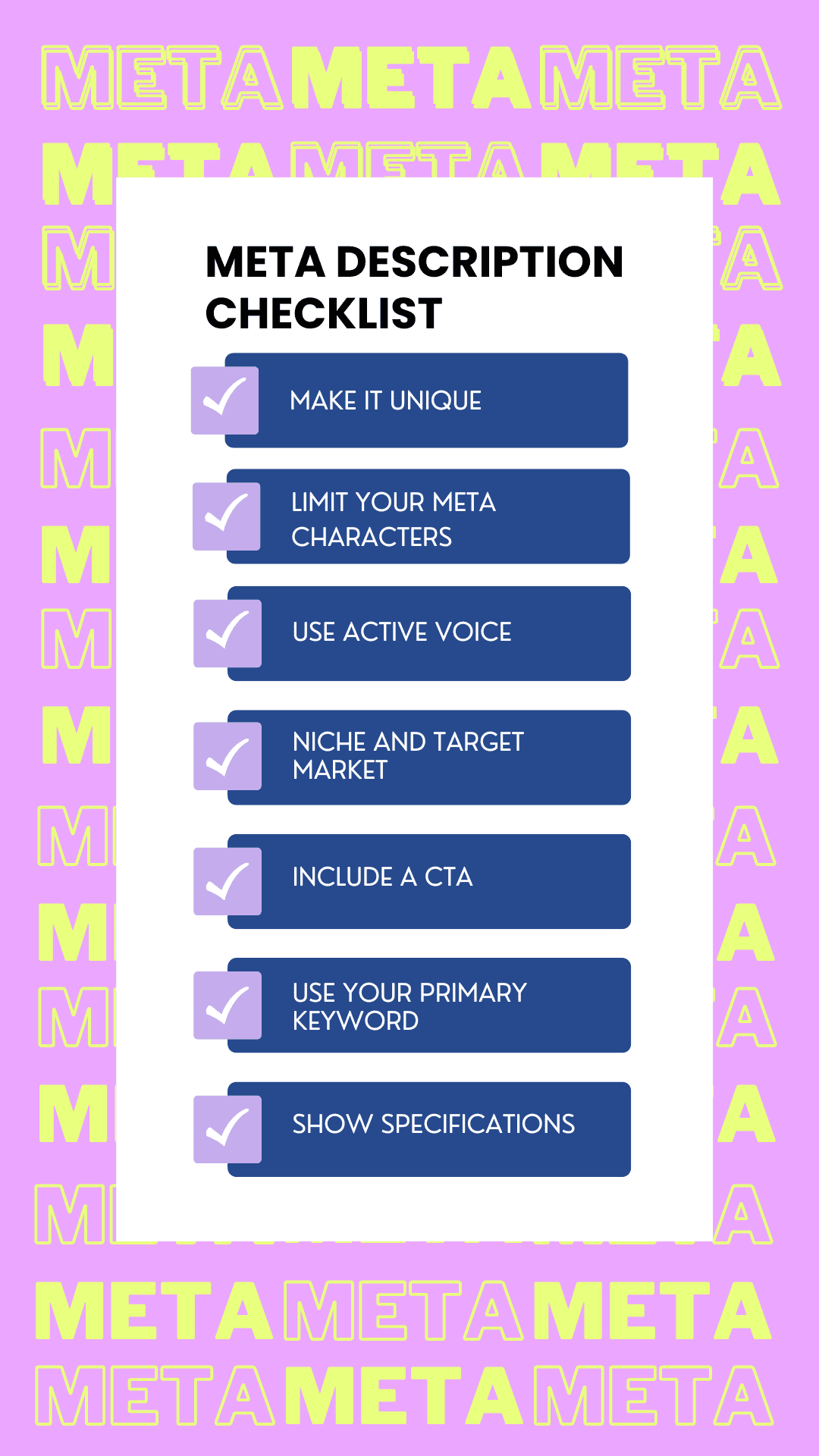
1. Limit your meta characters
Your meta description should be 155 characters, as Google mostly sees snippets between 120 and 156 characters. Moreover, you cannot fully control what Google displays as your meta description in search results. Sometimes it shows the manual meta description you added, while sometimes it shows an excerpt from the copy.
2. Use active voice in your meta description
A meta description is seen as an invitation for your readers to visit your page. Therefore, you should not make your meta description dull or difficult to understand. You should always consider what people are looking for on your page.
3. Include a CTA or call to action
Your meta description is your sales text and should always include what you are trying to sell.
4. Use your primary keyword
Using your primary keyword in your meta description will help Google get more interest in your content and rank it in the search engine results page.
5. Show specifications if necessary
Aim for the USP of your products to attract more visitors. For example, if you are selling a smart watch, your meta description can be like, “Does your smart watch have this new AI feature? Buy from us and experience AI like never before.”
6. Make it unique
You should never make your meta description the same for all the pages. Different pages should have different meta descriptions. Therefore, writing unique meta descriptions for all pages can help you rank on Google.
Case Study: Abhishek Aggarwal’s SEO Optimization Success Story
Background
Abhishek Agarwal is a Google-certified SEO manager at seobyinventiv.com. He took on a challenging project for a client in the E-Commerce space. The client is an online fashion retailer and was troubled to generate conversion leads despite having a strong product and an attractive website design.
Challenge
The client then approached Abhishek, intending to increase traffic to the website, improve search engine rankings, and ultimately increase conversion rates. The previous SEO efforts of clients had fallen short, and they needed a good strategy to turn things around.
Approach
Abhishek Agarwal then used his 7 years of experience in SEO and conversion rate optimization to design a targeted plan. He started by conducting thorough research on keywords while identifying the potential keywords that have good search volume and relevance to the product of the client.
Checklist implementation
1. Meta name and outline optimization
Abhishek Agarwal applied the checklist for converting meta titles and descriptions. He ensures that each web page has a unique and keyword-wealthy meta title and outline, attracting users to click via search effects.
2. Content Optimization:
Abhishek used his content introduction talents, optimized the descriptions of the present product, and created new and exciting content. He centred on incorporating key phrases, enhancing readability, and highlighting particular selling factors to draw and preserve users.
3. Technical search engine optimization and link building:
Abhishek implemented technical search engine marketing practices, together with optimizing website speed, enhancing cellular responsiveness, and solving move-slowly errors. He also achieved a strategic link-building campaign to grow the website’s authority and visibility online.
4. Data-Driven Insights:
Throughout the campaign, monitored performance metrics and the usage of analytics tools. He analyzed statistics to discover developments, alter strategies, and refine search engine marketing campaigns for the greatest results.
Results:
Abhishek’s efforts yielded significant improvements for the client:
- Increased Website Traffic: Through better meta title tags, the search engine rankings improved, and a 30% increase in organic website traffic was recorded after three months.
- Higher Conversion Rates: With effective copywriting and a user-friendly interface, Abhishek led to a growth of 20% of the conversion of the client, which brought more revenue to their business.
- Improved User Retention: discovery and adoption of SEO and CRO by us together resulted in superior user engagement and retention, with bounce rates reducing by 15%.
- ROI Growth: Clients have experienced a remarkable return on investment (ROI) due to the incredible results that Abhishek delivers through the SEO and CRO improvements, which have yielded a 40% revenue rise.
Conclusion
A highly optimized site, and most importantly, Abhishek Aggarwal’s SEO application with experience as a CRO and data analysis knowledge, was the success key for his client. Abhishek, leveraging the checklist and top industry techniques, succeeded, as he not only achieved good ranks in search visibility and visits but also generated more conversions and money through that.
Make it a rule for yourself to compose the best meta title/description possible; otherwise, your website traffic and user interaction rates will go down.
FAQs
Q1: What is a word meta description?
A: A meta description is an HTML element that provides Google as well as your audience with a brief summary of your page or the content on that page.
Q2: Is a meta description SEO?
A: Yes, meta description is a crucial part of SEO. Moreover, its your chance to attract users to click on your search results.
Q3: Why is the meta description important?
A: Meta description is important as it gives your readers a gist about your page or the content on the page and invites them to click on your search results.
Q4: How long are meta descriptions?
A: According to Google, meta descriptions should be between 120 and 156 characters.
Q5: What are the pixels of the meta description?
A: The pixel length of the meta description can be 920 pixels on a laptop, whereas it can be 680 pixels on mobile screens.



2 Replies to “Meta Title/Description Guide: 2024 Best Practices”